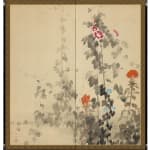Takeda Koyō
Hollyhocks, Morning Glories, and “Maltese Cross”, ca 1925
Pair of two-panel folding screens; ink and colors on paper
Size for the pair: 61½ x 116 in.
Size each screen: 61½ x 57¾ in. (156.5 x 147 cm)
Size each screen: 61½ x 57¾ in. (156.5 x 147 cm)
T-1317
Further images
-
(View a larger image of thumbnail 1
)

-
(View a larger image of thumbnail 2
)

-
(View a larger image of thumbnail 3
)

-
(View a larger image of thumbnail 4
)

-
(View a larger image of thumbnail 5
)

-
(View a larger image of thumbnail 6
)

-
(View a larger image of thumbnail 7
)

-
(View a larger image of thumbnail 8
)

-
(View a larger image of thumbnail 9
)

-
(View a larger image of thumbnail 10
)

-
(View a larger image of thumbnail 11
)

-
(View a larger image of thumbnail 12
)

-
(View a larger image of thumbnail 13
)

Signature: Koyō; seal: Koyō In this large-scale composition spread across a pair of two-panel screens, Takeda Koyō brings together three flowering plants that thrive in the humid heat of Japan’s...
Signature: Koyō; seal: Koyō
In this large-scale composition spread across a pair of two-panel screens, Takeda Koyō brings together three flowering plants that thrive in the humid heat of Japan’s high summer. The right-hand panel of the left-hand screen is dominated by a tall stem of tachiaoi (hollyhock), itself partly covered in leaves and blossoms of asagao (morning-glory) creeper; to its left and right are stems of a less familiar flower, yaguruma sennō (Lychnis chalcedonica), often known in English as “Maltese cross”
or “Jerusalem cross”; the yaguruma (“arrow wheel”) component of the Japanese name refers to the distinctive shape of the flower which, when fully open, resembles the windmills attached to poles on which carp streamers are raised. On the right-hand screen, asagao weighs down a stem of another plant whose flowers have already fallen, while to the left of the main grouping further tendrils of asagao, rendered in a faint ink wash, recede into the distance. In the lower foreground, a spattering of white pigment suggests a recent heavy fall of summer rain and the wetness of the leaves is emphasized through liberal use of the tarashikomi technique, in which pigment and ink are applied to earlier layers of paint that have not fully dried to create random, half-controlled effects. Combined with the ink-wash seen elsewhere on the screens, this use of tarashikomi attests to Koyō’s mastery of two strands within the Kyoto painting tradition: Shijō naturalism and a Rinpa-inspired love of surface effects.
In this large-scale composition spread across a pair of two-panel screens, Takeda Koyō brings together three flowering plants that thrive in the humid heat of Japan’s high summer. The right-hand panel of the left-hand screen is dominated by a tall stem of tachiaoi (hollyhock), itself partly covered in leaves and blossoms of asagao (morning-glory) creeper; to its left and right are stems of a less familiar flower, yaguruma sennō (Lychnis chalcedonica), often known in English as “Maltese cross”
or “Jerusalem cross”; the yaguruma (“arrow wheel”) component of the Japanese name refers to the distinctive shape of the flower which, when fully open, resembles the windmills attached to poles on which carp streamers are raised. On the right-hand screen, asagao weighs down a stem of another plant whose flowers have already fallen, while to the left of the main grouping further tendrils of asagao, rendered in a faint ink wash, recede into the distance. In the lower foreground, a spattering of white pigment suggests a recent heavy fall of summer rain and the wetness of the leaves is emphasized through liberal use of the tarashikomi technique, in which pigment and ink are applied to earlier layers of paint that have not fully dried to create random, half-controlled effects. Combined with the ink-wash seen elsewhere on the screens, this use of tarashikomi attests to Koyō’s mastery of two strands within the Kyoto painting tradition: Shijō naturalism and a Rinpa-inspired love of surface effects.












